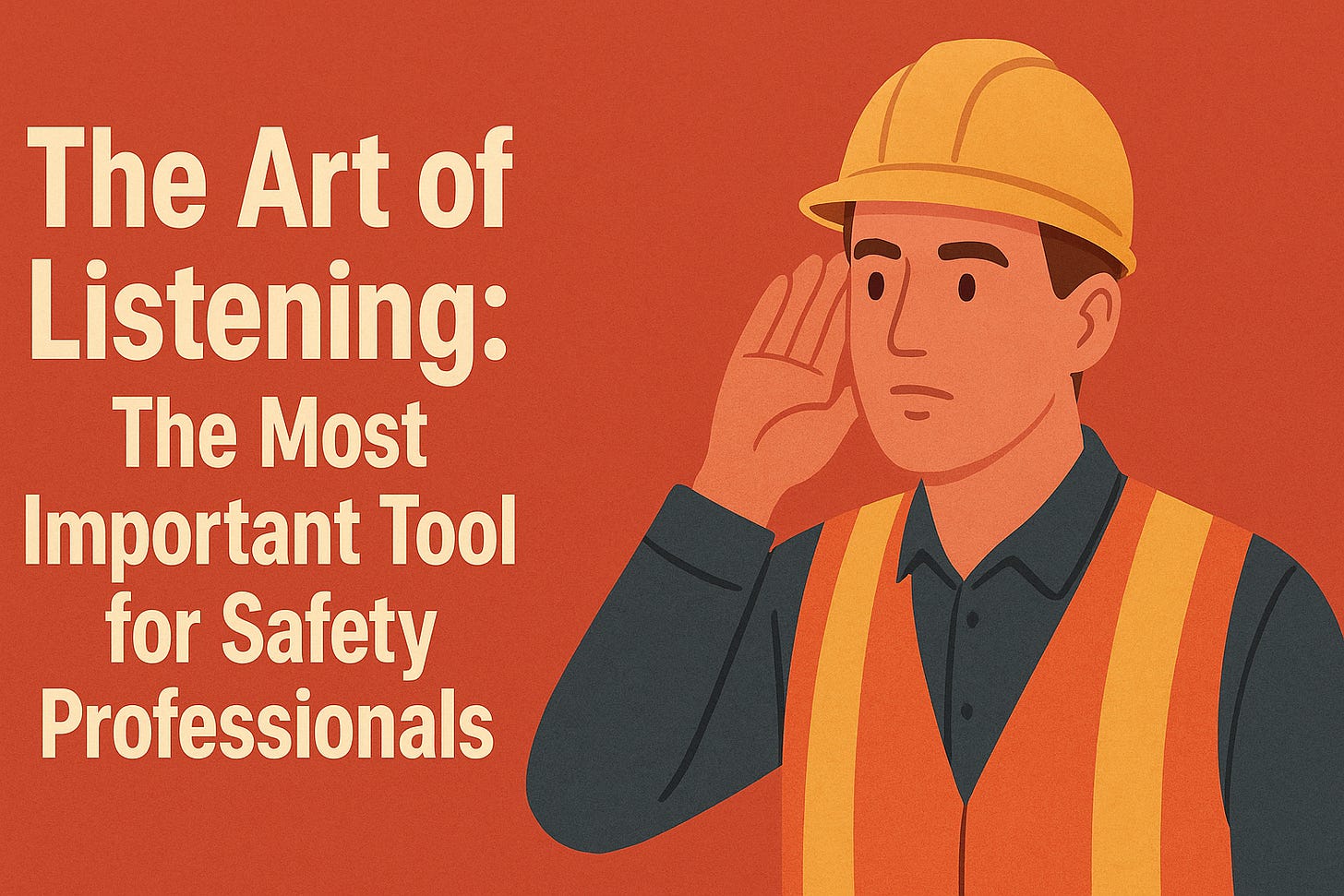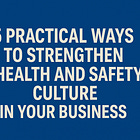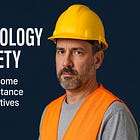The Art of Listening: The Most Important Skill for Safety Professionals
Hello and welcome to this week’s edition of Safety Pro Weekly.
As safety professionals, we spend a lot of time talking.
We talk about policies, procedures, incidents, and performance. We teach, we coax, we cajole, but how often do these messages fall flat? If you’re like me, pretty damn often.
It’s a hard lesson for most of us to learn, but sometimes the real breakthroughs don’t come from the words we say. They come from the moments we stop talking and start listening.
I learned this the hard way.
Early in my career, I thought strong leadership meant always having the answer. When someone brought me a problem, I jumped straight into solution mode. It took a few years, and a few costly lessons, to realize that the best insights often come from the people doing the work. You just have to give them space to speak.
Listening is one of the most overlooked leadership skills. And yet it’s foundational to building a strong health and safety culture.
Culture can’t be dictated.
You can’t direct someone to care about safety. Sure you can direct and enforce certain safe behaviours, but you can’t control what employees do when they’re not being watched. That’s when you have to rely on culture to get real buy-in and you can’t have a strong culture without listening to the ideas, concerns, and challenges your workers face every day.
In safety, where every conversation has the potential to prevent harm, it’s critical that we develop this skill.
Why Listening Matters: You Can’t Lead What You Don’t Understand
Most safety professionals are good communicators.
We know how to explain, instruct, and motivate. But it’s easy to forget that communication is a two-way process, and too often we mistake broadcasting for leading.
When we listen, we learn what’s really happening on the shop floor. We learn what shortcuts creep in when employees are under pressure, the frustrations workers face, and the simple ideas that could make work safer.
Listening builds trust. It signals respect. And it gives workers confidence that their experiences matter.
As one supervisor told me, “People will tell you everything you need to know, if you give them the opportunity to say it.”
The Barriers to Listening: Why We Miss the Message
Even the most experienced leaders fall into common listening traps.
We rush to fix instead of understand.
We multitask during conversations.
We assume we already know what’s being said.
And sometimes, let’s admit, we simply don’t want to hear it.
Listening requires the willingness to be surprised by what we hear. It means admitting we don’t always have the answers, and that the best ideas might come from someone else.
When we let go of the need to talk, we create space for the insights of others to emerge.
The Practice of Listening: Turning Attention into Action
Listening isn’t passive. It’s an active skill that can be practiced and refined.
Here are four habits that separate great safety leaders from the rest:
1. Be fully present. When someone speaks, give them your full attention. Put away distractions your phone, email, or clipboard. Eye contact and attention matter. Let’s put it another way, how do you feel when you’re trying to talk about something important to you and the other person won’t stop glancing at their phone? Is this the message you want to subconsciously express to others when they come to you?
2. Ask open-ended questions. Try “What have you struggled with lately?” or “What could make this job easier or safer?” You’ll be surprised what comes out.
3. Listen for meaning, not just words. This can be a tough skill to learn and it takes practice and patience. Pay attention to things like the other person’s tone, hesitation, and emotion. What someone doesn’t say can be even more important than what they do.
4. Act on what you hear. Listening without follow-up erodes trust. When workers see action, they know their voices matter. Even if it’s not the resolution the employee was hoping to see, clear follow up makes people feel heard and understood.
Real listening changes how people feel about speaking up. When they feel comfortable coming to you with a concern, you’ll learn things that will help you prevent future accidents.
Characteristics of a Good Listener
Being a good listener is something most of us have to work at. Many of us didn’t have the greatest role models growing up and listening is not a skill often taught in school or other learning scenarios. For all the professional development courses out there teaching people to speak, there aren’t nearly as many teaching us how to listen well.
Here are some characteristics to work on if you want to improve your listening skills:
Curiosity. Good listeners are genuinely curious, ask open-ended questions, and look at conversations as opportunities to learn something new.
Patience. Don’t interrupt when others are speaking. Let them fully express their thought and then respond.
Empathy. Listen for emotion as much as you listen for facts. You don’t have to necessarily agree, but try to see things from the other person’s point of view.
Reflectiveness. Good listeners take the time to paraphrase the speaker’s words so they can confirm that they understand.
Non-defensiveness. Being defensive kills conversations. Treat feedback as information, not an attack.
Presence. Give your undivided attention when listening to someone. This communicates respect for the other person and encourages others to open up.
Discretion. Handle sensitive information carefully and never use it in any way that would not be welcomed by the other person.
True leadership isn’t loud. It doesn’t need to fill every silence. It’s calm, observant, and intentional. The strongest safety leaders understand that wisdom begins in listening.
Every conversation is a chance to make work safer. But that only happens when we stop talking long enough to truly hear what people are trying to tell us. Master the art of listening, and you’ll master one of the most powerful tools in safety leadership.
That’s it for this week, let me know in the comments some of the ways you’re working on becoming a better listener. I promise to listen carefully 😊
Safety Pro Weekly is published every Tuesday morning on LinkedIn and Substack. Please share this article with someone you think would benefit.
Cheers,
Dan.







Great article and very applicable to leadership practices in all areas.